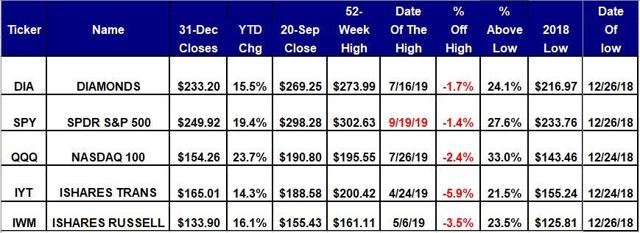[ad_1]
Here’s Today’s Scorecard
SPDR Dow Jones Industrial Average ETF (NYSEARCA:DIA)
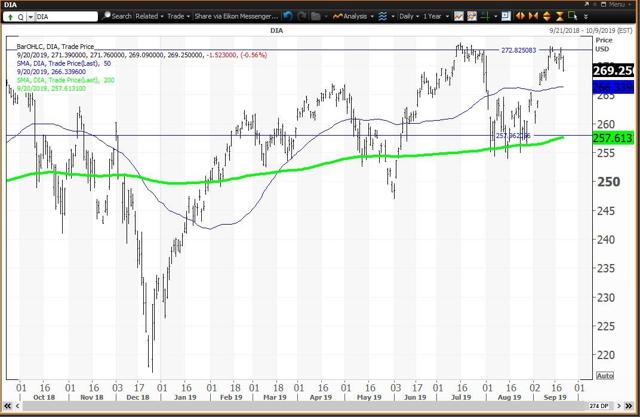 Courtesy of Refinitiv XENITH
Courtesy of Refinitiv XENITH
The Diamonds ETF is 24.1% above its 2018 low of $216.97 set on Dec. 26 and is 1.7% below its all-time intraday high of $273.99 set on July 16. Diamonds has a positive weekly chart with the ETF above its five-week modified moving average at $266.60, with its 12x3x3 weekly slow stochastic reading rising to 67.49 last week, up from 61.04 on Sept. 13. Its annual pivot is $257.94 with its semiannual pivot at $272.78 and quarterly and monthly risky levels at $285.35 and $287.97, respectively. A weekly value level is $258.51.
SPDR S&P 500 Trust ETF (NYSEARCA:SPY)
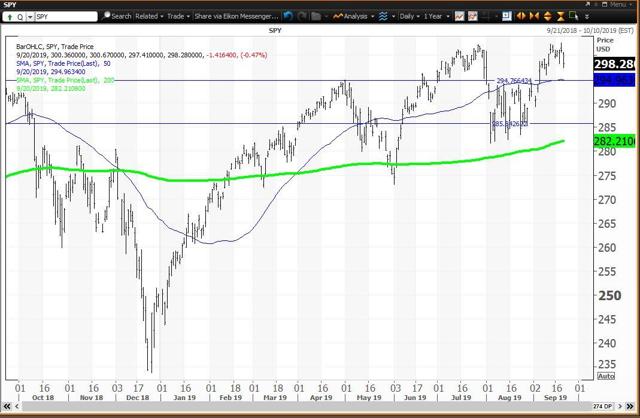 Courtesy of Refinitiv XENITH
Courtesy of Refinitiv XENITH
The Spiders ETF is 27.6% above its Dec. 26 low of $233.76 and set its all-time intraday high of $302.63 on Sept. 19 versus the July 26 high of $302.23. Spiders has a positive weekly chart with the ETF above five-week MMA at $295.27, with its 12x3x3 weekly slow stochastic reading rising to 71.59 last week, up from 65.35 on Sept. 13. The annual pivot is $285.86 with a semiannual pivot at $294.72 and quarterly and monthly risky levels at $305.22 and $319.09, respectively. A weekly value level is $262.10.
Invesco QQQ ETF (NASDAQ:QQQ)
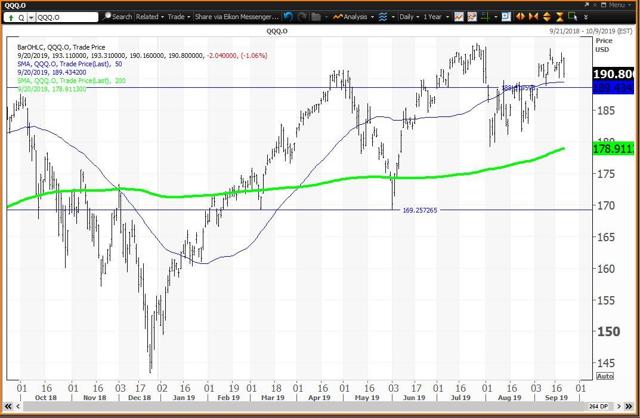 Courtesy of Refinitiv XENITH
Courtesy of Refinitiv XENITH
The QQQ ETF is 33% above its 2018 low of $143.46 set on Dec. 24 and is 2.4% below its all-time intraday high of $195.55 set on July 26. QQQ has a positive weekly chart with the ETF above its five-week MMA at $189.13, with its 12x3x3 weekly slow stochastic reading rising to 68.80 last week, up from 65.15 on Sept. 13. The annual value level is $169.27 with a semiannual pivot at 188.63 and its quarterly and monthly risky levels at $201.51 and $209.60, respectively. A weekly value level is $181.29.
iShares Transportation Average ETF (NYSEARCA:IYT)
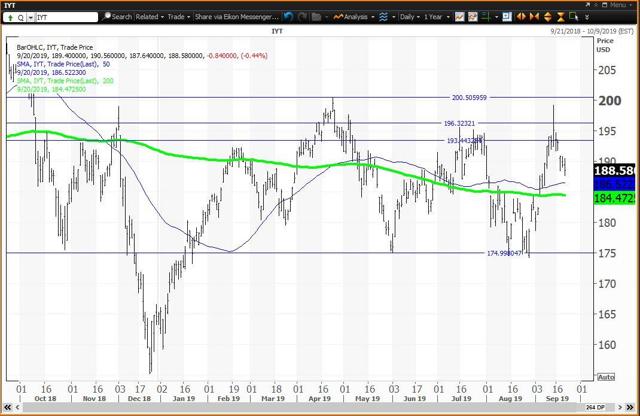 Courtesy of Refinitiv XENITH
Courtesy of Refinitiv XENITH
IYT is 21.5% above its 2018 low of $155.24 set on Dec. 24 and is 5.9% below its 2019 high of $200.42 set on April 24. The weekly chart for IYT is positive with the ETF above its five-week MMA at $186.81, with its 12x3x3 weekly slow stochastic reading rising to 50.59 last week, up from 43.39 on Sept. 13. I show a semiannual pivot at $193.47 with annual, quarterly and monthly risky levels at $196.35, $200.49 and $206.83, respectively. A weekly value level is $182.10.
iShares Russell 2000 ETF (NYSEARCA:IWM)
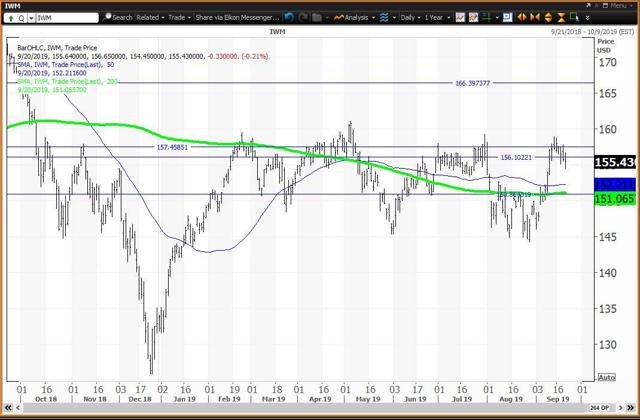 Courtesy of Refinitiv XENITH
Courtesy of Refinitiv XENITH
IWM is 23.5% above its 2018 low of $125.81 set on Dec. 26 and is 3.5% below its 2019 high of $161.11 set on May 6. IWM has a positive weekly chart with the ETF above its five-week MMA at $152.61. Its 12x3x3 weekly slow stochastic reading rose to 47.73 last week, up from 38.33 on Sept. 13. Semiannual and annual pivots are $156.14 and $157.49, respectively, with quarterly and monthly risky levels at $166.36 and $171.17, respectively. A weekly value level is $150.14.
How to use my value levels and risky levels:
Value levels and risky levels are based upon the last nine weekly, monthly, quarterly, semiannual and annual closes. The first set of levels was based upon the closes on Dec. 31. The original annual level remains in play.
The weekly level changes each week. The monthly level changes at the end of each month, the latest on Aug. 30. The quarterly level was changed at the end of June.
My theory is that nine years of volatility between closes are enough to assume that all possible bullish or bearish events for the stock are factored in.
To capture share price volatility, investors should buy on weakness to a value level and reduce holdings on strength to a risky level. A pivot is a value level or risky level that was violated within its time horizon. Pivots act as magnets that have a high probability of being tested again before its time horizon expires.
How to use 12x3x3 Weekly Slow Stochastic Readings:
My choice of using 12x3x3 weekly slow stochastic readings was based upon back-testing many methods of reading share-price momentum with the objective of finding the combination that resulted in the fewest false signals. I did this following the stock market crash of 1987, so I have been happy with the results for more than 30 years.
The stochastic reading covers the last 12 weeks of highs, lows and closes for the stock. There is a raw calculation of the differences between the highest high and lowest low versus the closes. These levels are modified to a fast reading and a slow reading and I found that the slow reading worked the best.
The stochastic reading scales between 00.00 and 100.00, with readings above 80.00 considered overbought and readings below 20.00 considered oversold. Recently, I noted that stocks tend to peak and decline 10% to 20% and more shortly after a reading rises above 90.00, so I call that an “inflating parabolic bubble” as a bubble always pops. I also call a reading below 10.00 as being “too cheap to ignore.”
Disclosure: I/we have no positions in any stocks mentioned, and no plans to initiate any positions within the next 72 hours. I wrote this article myself, and it expresses my own opinions. I am not receiving compensation for it (other than from Seeking Alpha). I have no business relationship with any company whose stock is mentioned in this article.
[ad_2]
Source link Google News


